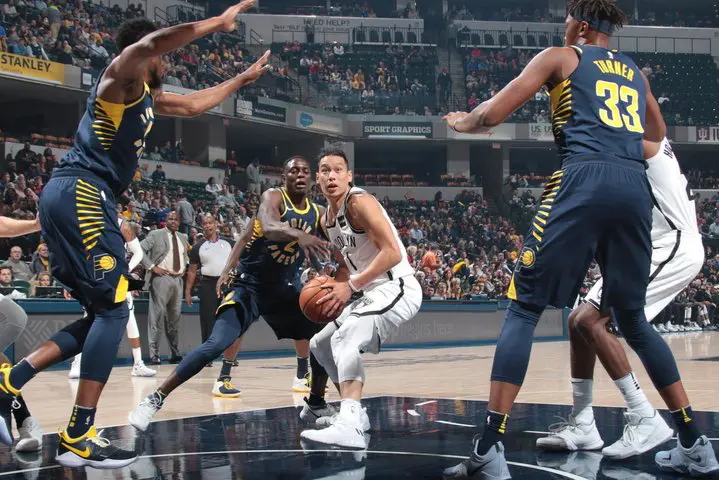The review of Jeremy Lin’s season isn’t a review as much as it’s a projection for 2018-19. In his second year with the Brooklyn Nets, Lin ruptured his patellar tendon after playing just 25 minutes against the Indiana Pacers on opening night. It was the only time he saw the court. For the last six months and counting, the 29-year-old has been rehabbing with the intent of changing how he uses his body on a physiological level.
A Lesson In Physiology
During an interview with the Associated Press in April, Lin explained how his changes wouldn’t be visible to the naked eye, “but it will be very different in terms of how I do it, where I move from and what muscles I’m using and what tendons and joints I’m not using.” In that, he confirms that his style will remain the same, and he won’t have to spend additional time trying to re-work himself into Kenny Atkinson’s system.
This somewhat drastic alteration comes after playing 37 games in two years. During 2016-17, Lin suited up for 36 contests while dealing with a hamstring problem. His first two years in Brooklyn have nearly been lost entirely, but there’s still time for him to make enough of an impact to warrant a second contract with the team. His talent is undeniable. But no organization wants to pay someone who can’t contribute. To Lin’s credit, though, he stayed with the team for most of the recent campaign and was easily identifiable because of his bold wardrobe. Despite being limited to a seat on the bench, he did everything in his power to feed knowledge to his young teammates, acting as an extra assistant almost.
Jeremy Lin Visits MIT
Back in February, Jeremy Lin spoke on two panels at the MIT Sloan Analytics Conference. The first centered on social media. The second was on ESports and their boom in using analytics. Neither was significant concerning basketball. And that’s fine. It’s common to see athletes dive into different sectors and not be about their occupation 100 percent of the time. It’s also not detrimental because he’s tackling subjects to help inform droves of younger athletes and younger people. ESports is a booming industry, and everything is so accessible now that it’s vital for high-profile individuals to understand how to carry themselves when the world is watching.
Months earlier, though, Lin was hobbling off a basketball court with tears rolling down his cheek. He exited that game with 18 points and four assists. He was aggressive and prioritized getting downhill, traits that were prevalent during his first season with the Nets. Expect that to continue going forward.
Lin’s ability to collapse the defense and free up shooters helps the offense run more smoothly. He’s also capable of getting his own shot if that’s what’s open. Additionally, having a veteran ball handler means sets aren’t going to get rushed, and bad shots (hopefully) won’t be thrown up as often. The younger Nets often struggled with bad decision-making, and it cost them a few close games. Lin can settle everyone down if they start leaning too far in one direction.
Looking Ahead
For this upcoming season, it’s vital for Jeremy Lin is to make sure his body is ready for the workload that’s expected of him. I’m not a medical professional. I have no advice on that. When he returns to the court, however, pick-and-roll mastery and three-point accuracy are the two ways Lin can make his presence felt.
Long-range shooting has slowly become a more prominent part of his arsenal, and he set a career-high in 2017 with an average of 4.3 threes attempted per game. He connected 37.2 percent of the time. When he’s surrounded by D’Angelo Russell or Joe Harris or Spencer Dinwiddie or DeMarre Carroll, the focus shifts to getting them the best shot possible.
Lin is fantastic at extending the pick-and-roll, taking that extra dribble or two to occupy multiple defenders. That, in turn, leaves someone open, and he can initiate a swift reversal for an uncontested shot. In a system that prioritizes ball movement and gives almost everyone the green light, those opportunities are abundant.
Jeremy Lin, unlike his teammates, will not receive a grade on his performance this season. It’s out of respect because, well, he barely played. Going forward, however, he’s going to be necessary for any success the team has.
2017-18 Per-Game Stats:
- Minutes: 25.0
- Points: 18.0
- Rebounds: 0.0
- Assists: 4.0
- Field Goal Percentage: 41.7%
- Three Point Field Goal Percentage: 50.0%
- Free Throw Percentage: 100.0%
2017-18 Per 36 Stats:
- Points: 25.9
- Rebounds: 0.0
- Assists: 5.8
- Field Goal Attempts: 17.3
- Three Point Field Attempts: 2.9
- Free Throw Attempts: 10.1


